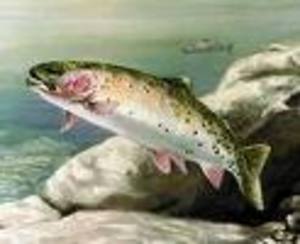One of the most enjoyable ways to catch trout is with worms, and in this article I’m going to outline some tips and tricks that will help you be much more successful when trout fishing with worms. When I refer to the word ‘worms’ that would include live worms, Berkley Power Worms, and Berkley Gulp worms. All three of these options produce results when trout fishing. Is one of the options better than the others? I’ll leave that up to you, because for me they all work quite well, especially when the tips and tricks in this article are employed.
Let’s begin with the basics, and what’s more basic than your hands? Keeping your hands free of unnatural odors is of the utmost importance when trout fishing. Trout have a very keen sense of smell and can easily detect unnatural odors such as gasoline residue from filling up your tank or smoke from choking down cigarettes. Guess what happens if a trout detects an unnatural odor? Yep, they are much less apt to bite your worm. A great way to make sure that your hands are free of any unnatural odors is to grab a handful of grass or dirt before baiting up and rubbing it into your hands. This effectively “washes” your hands, and frees them from any unnatural odors that might be present.
The next, and probably most important tip is to always use gang hooks fishing for trout with worms (no matter what type of worm you happen to be using). Gang hooks allow you to present the worm in an outstretched manner, the way God (and the trout) intended. Gang hooks also help with hooking those ‘short striking’ fish. You know, the fish that tend to bite the tail off of your worm? In any case, if you want to know how to fish for trout with worms, gang hooks are an integral part.
So how exactly do you fish for trout with worms? I’m going to outline exactly how to do it when fishing in the flowing waters of a river or stream. Start by taking the end of your line and tying on a small barrel swivel. The size of the barrel swivel should correlate with the size of your line (which incidentally should be no heavier than six-pound test for trout fishing). Now tie a set of gang hooks onto the opposite end of the barrel swivel. Now split shot sinkers are added for weight, depending on current flow.
The goal is to have the offering bounce or “roll” along the bottom as it flows naturally with the current. With practice you will easily be able to distinguish the difference between the bottom and bites. This can be difficult at first, but you’ll get the hang of it. This natural presentation and technique is a deadly method for catching trout (or any other fish) in the flowing water of a river or stream. The key is the gang hook rig, baited with your favorite variety of worm.
If you want to know how to fish for trout with worms, what I just outlined is it. This technique is as effective a fish catching technique as you will ever find. Oh, and don’t worry about getting snagged and breaking off. Getting snagged is simply part of the technique, and as my mentor used to say, “if you’re not getting snagged, you’re not fishing in the right place.”
